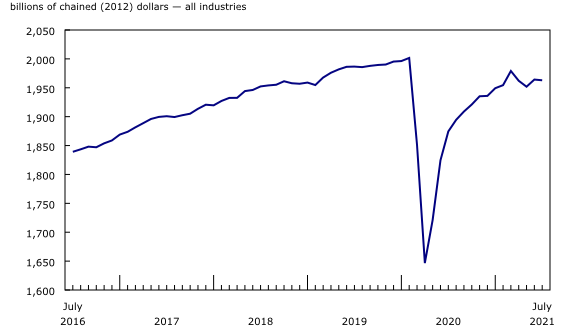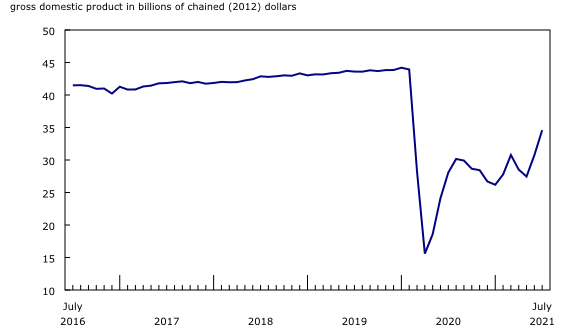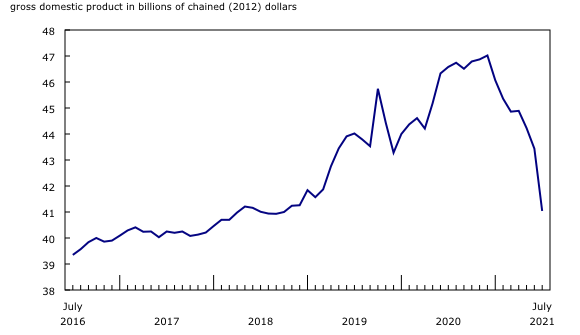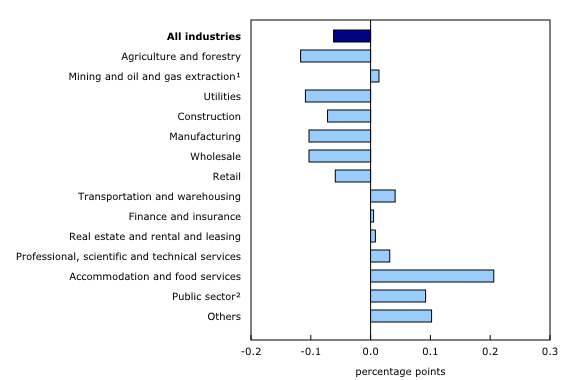Gross domestic product by industry, July 2021
Archived Content
Information identified as archived is provided for reference, research or recordkeeping purposes. It is not subject to the Government of Canada Web Standards and has not been altered or updated since it was archived. Please "contact us" to request a format other than those available.
Released: 2021-10-01
July 2021
-0.1% 
(monthly change)
Real gross domestic product (GDP) edged down 0.1% in July following a 0.6% increase in June. Total economic activity in July was approximately 2% below the pre-pandemic level of February 2020.
Overall, 13 of 20 industrial sectors were up, led by a second strong monthly increase in the accommodation and food services sector. However, these increases were more than offset by declines in agriculture, utilities, manufacturing and wholesale trade.
Preliminary information indicates an approximate 0.7% increase in real GDP for August. The increases in the accommodation and food, manufacturing and retail trade sectors were partly offset by lower activity in agriculture, as drought conditions continued to impact crop production. Because of its preliminary nature, this estimate will be revised on October 29 with the release of the official GDP data for the August reference month.
Easing of public health measures helps growth in accommodation and food services
The accommodation and food services sector rose 12.5% in July, the second double-digit growth in a row. Both subsectors were up.
Food services and drinking places rose 9.5%, following a 14.4% gain in June. Summer weather, expanded patio capacity and loosened public health restrictions on indoor and outdoor dining across the country, all contributed positively to the growth.
Accommodation services rose 21.2% in July, driven by a jump in traveller accommodation, as both domestic and international travel rose in the month. As of July 5, fully vaccinated eligible travellers entering Canada were no longer required to complete a mandatory 14-day quarantine.
Growth in the arts, entertainment and recreation sector
The arts, entertainment and recreation sector was up 8.1% in July, mainly on the strength of the amusement, gambling and recreation industries. The easing of restrictions across many parts of the country facilitated reopening or increased capacity at amusement parks, indoor and outdoor recreational facilities (including gyms, yoga studios, pools, and arenas) and casinos.
Transportation rises
The transportation and warehousing sector grew 1.1% in July, following a 0.8% uptick in June, with growth in air transportation leading the way. Air transportation rose 67.7% as movements of passengers both domestically and internationally increased. There was also an uptick in the movement of goods. Nevertheless, the air transportation subsector was nearly 83% below its pre-pandemic level of activity.
Support activities for transportation rose 2.4%, while transit, ground passenger, and scenic and sightseeing transportation (+3.4%) benefitted from an increase in public transit ridership. Offsetting some of the gains were postal service, couriers and messengers (-2.3%) and rail transportation (-1.8%).
Extreme heat stymies agriculture, forestry and fishing
Agriculture, forestry, fishing and hunting dropped 5.5% in July as record-setting heat and drought conditions in Western Canada greatly affected the national annual crop production estimates.
Crop production (except cannabis) dropped 13.2% in July, reaching its lowest level since the fall of 2007, driven by ongoing drought conditions in Western Canada which have severely impacted wheat, canola and other grains production.
Forestry and logging was down in July (-3.9%), as forest fires in British Columbia's interior and in northwestern Ontario affected production activities. Animal production rose 2.9%, while support activities for agriculture and forestry were unchanged.
Utilities contract
After increasing 3.6% in June, utilities fell 4.9% in July, driven by a drop in electric power generation, transmission and distribution (-6.0%). Even though Western Canada continued to endure extreme heat and drought, cooler-than-usual temperatures in central and eastern regions of the country led to a decrease in national demand for electricity for cooling purposes.
Natural gas distribution edged down 0.3%, while water, sewage and other systems fell 0.9%.
Manufacturing declines
The manufacturing sector contracted 1.1% in July, largely driven by declines in durable-goods manufacturing.
Durable-goods manufacturing decreased 1.9% in July, the third decline in four months. Miscellaneous (-12.2%), fabricated metal product (-5.2%) and non-metallic mineral product (-4.6%) manufacturing were the main factors in this drop.
Non-durable goods manufacturing edged down 0.1%, and its subsectors were evenly split between increases and decreases. Gains in food (+1.6%) and plastics and rubber products (+3.3%) manufacturing were more than offset by declines in chemical (-2.8%), printing and related support activities (-6.5%) and petroleum and coal product (-1.0%) manufacturing.
Construction continues to fall
Construction contracted 0.9% in July, a third consecutive decline, largely as a result of lower residential building construction.
Residential building construction fell 2.7% in July, a third straight monthly decline, after reaching a record high in April. Almost all types of residential buildings construction activity were down, led by single-family homes and home alterations and improvements.
Repair construction decreased 1.6% while engineering and other construction activities rose 1.1%.
Non-residential building construction was up 0.5%, as an increase in institutional building construction more than offset drops in commercial and industrial building construction.
Wholesale continues to decline
Wholesale trade fell 1.9% in July, down for the fourth month in a row. Seven of the nine subsectors were contracted, and building material and supplies wholesaling (-9.0%) was responsible for most of the decline.
Offsetting some of the drop were machinery, equipment and supplies (+0.3%) and petroleum and petroleum products wholesaling (+0.9%).
Public sector continues to grow
The public sector (educational services, health care and social assistance, and public administration) advanced 0.4% in July.
Health care and social assistance increased 0.6% as all its subsectors were posting gains, but the increase was led by ambulatory health care services (+1.0%) and hospitals (+0.2%).
The educational services sector advanced 0.5% as all its industries were up, but the increase was led by elementary and secondary schools (+0.4%) and universities (+0.4%).
Public administration edged up 0.2%, with gains observed in the majority of subsectors were up. Local, municipal and regional public administration (+0.8%) and provincial and territorial public administration (+0.3%) rose, as a number of provinces entered new phases of reopening in July. Federal government public administration contracted 0.3%.
Other industries
Retail trade decreased 1.1% in July, with 7 of 12 subsectors posting declines. Food and beverage stores (-3.3%) and building material and garden equipment and supplies dealers (-6.5%) were the biggest factors in the decline, while clothing and clothing accessories stores (+6.2%) and general merchandise stores (+0.8%) offset some of the decreases.
Other services (except public administration) rose 2.5% in July, as the majority of subsectors were posting increases, led by personal and laundry services (+8.8%) and religious, grant-making, civic, and professional and similar organizations (+1.6%).
Professional, scientific and technical services grew 0.5% in July. All industries were up, except legal services (-0.1%), which edged down in July, posting its fourth straight monthly decrease. Similarly, output at the offices of real estate agents and brokers was down for the fourth month in a row, as home resale activity across the country continued to cool following a peak in the first quarter of 2021.
Sustainable development goals
On January 1, 2016, the world officially began implementing the 2030 Agenda for Sustainable Development—the United Nations' transformative plan of action that addresses urgent global challenges over the following 15 years. The plan is based on 17 specific sustainable development goals.
The release on gross domestic product by industry is an example of how Statistics Canada supports global sustainable development goal reporting. This release will be used to help measure the following goal:

Note to readers
Monthly data on gross domestic product (GDP) by industry at basic prices are chained volume estimates with 2012 as the reference year. This means that the data for each industry and each aggregate are obtained from a chained volume index multiplied by the industry's value added in 2012. The monthly data are benchmarked to annually chained Fisher volume indexes of GDP obtained from the constant-price supply and use tables (SUTs) up to the latest SUT year (2017).
For the period starting in January 2018, data are derived by chaining a fixed-weight Laspeyres volume index to the prior period. The fixed weights are 2017 industry prices.
This approach makes the monthly GDP by industry data more comparable with expenditure-based GDP data, which are chained quarterly.
All data in this release are seasonally adjusted. For information on seasonal adjustment, see Seasonally adjusted data – Frequently asked questions.
An advance estimate of industrial production for August 2021 is available upon request.
For more information on GDP, see the video "What is Gross Domestic Product (GDP)?"
Revisions
With this release of monthly GDP by industry, revisions have been made back to January 2020.
Each month, newly available administrative and survey data from various industries in the economy are integrated, resulting in statistical revisions. Updated and revised administrative data (including taxation statistics), new information provided by respondents to industry surveys, and standard changes to seasonal adjustment calculations are incorporated with each release.
Real-time table
Real-time table 36-10-0491-01 will be updated on October 12, 2021.
Next release
Data on GDP by industry for August 2021 will be released on October 29, 2021.
Products
The User Guide: Canadian System of Macroeconomic Accounts (13-606-G) is available.
The Methodological Guide: Canadian System of Macroeconomic Accounts (13-607-X) is also available.
The Economic accounts statistics portal, accessible from the Subjects module of the Statistics Canada website, features an up-to-date portrait of national and provincial economies and their structure.
Contact information
For more information, contact us (toll-free 1-800-263-1136; 514-283-8300; STATCAN.infostats-infostats.STATCAN@canada.ca).
To enquire about the concepts, methods or data quality of this release, contact Ederne Victor (613-863-6876), Industry Accounts Division.
- Date modified:





